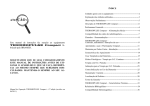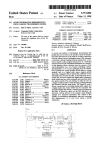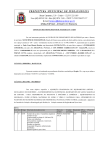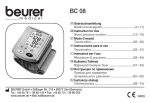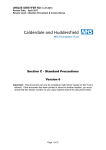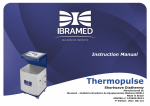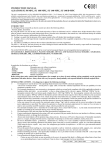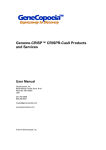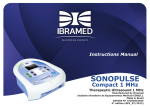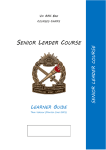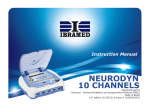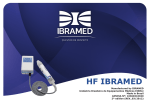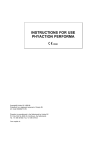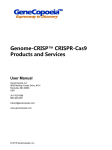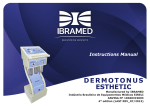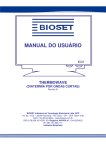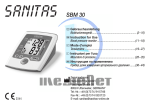Download Manual
Transcript
TABLE OF CONTENTS
ATTENTION:
General care with the Equipment………………….......................................2
Explanation of the symbols Used ..................................................................3
Electromagnetic Compatibility ……………………………………………..5
Preliminary Observations..........................................................................…12
THIS
MANUAL
OF
INSTRUCTIONS
REFERS
TO
THERMOPULSE COMPACT EQUIPMENT MANUFACTURED
BY IBRAMED.
Thermopulse compact Description...............................................................13
Essential performance ……………………………………………………..13
Compatibility with radio frequency cables ……………………...………...14
Electrodes – Recommendations ……………………..…………………….15
THERMOPULSE COMPACT - controls, indicators and operation ……..16
PLEASE READ THIS MANUAL
CAREFULLY BEFORE USING
THE EQUIPMENT AND ALWAYS
REFER TO IT WHENEVER
DIFFICULTIES APPEAR.
KEEP THIS MANUAL
ALWAYS AT HAND.
Short-wave Diathermy - Introduction…………………………………..…18
Heating Characteristics.................................................................................19
Therapeutic Diathermy use..........................................................................20
Physiological Effects - Continuous Short-Wave Therapy…....................…22
Pulsed Short Wave Therapy.........................................................................25
Indications for Pulsed Short Wave therapy ……………………………….30
Counter Indications to Diathermy Use ……………………………………31
Maintenance/ Warranty………….............................................................…33
Warranty term……………………………………………….……………..35
Sales Points ……………………………………………………………….37
Thermopulse Compact - Operation Manual Revised 4º Edition/06/
2011
THERMOPULSE TOWER - Technical Characteristics.............................38
Bibliography.................................................................................................39
Troubleshooting……………………………………………………………41
Free Technical Assistance Contract..............................................................42
1
2
GENERAL CARE WITH THE EQUIPMENT
CAUTION!
RISK OF ELECTRICAL SHOCK
DO NOT OPEN IT
¨ Install the equipment on a firm and horizontal surface,
in a place with perfect ventilation. Keep a near distance
of 30 cm between the rear part of the equipment and the
wall, in order not to block the hot air from coming out.
The lightning bolt symbol inside a triangle is a
warning about the presence of “dangerous
voltage”, without insulation in the internal part of
the equipment which may be strong enough to
cause risk of electrical shock.
An exclamation mark inside a triangle alerts the
user about the existence of important operation
and maintenance instructions (technical service)
for this equipment.
¨ During treatment, the electrode cables must always be
away from each other and must not touch the patient or any
metallic surface. It is advisable to use wooden furniture (with no
metallic parts).
¨ The patient under treatment must not touch the equipment cabinet
or metallic objects like furniture, windows, etc. Before starting the
treatment, make sure that the patient is not using bracelets, rings,
watches or any other metallic accessories.
¨ It is advisable to undress the patient in diathermy treatment and
place towels between the skin and the electrode, thus avoiding the
energy concentration due to transpiration or to the wearing of
synthetic clothes.
¨ In case of fitted closet, make sure that there is not any blocking of
the free air circulation in the rear part of the appliance.
¨ Avoid places exposed to vibration.
¨ Place the cable in order to leave it free, out of places where it can
be trodden on, and do not place any furniture over it.
ATTENTION: To prevent electrical shock do not use the equipment
plug attached to an extension cable or to any other type of plug
except that the terminals fit perfectly in the receptacle. Disconnect
the input plug from socket when not using the equipment for a long
period of time.
¨ Do not insert objects into equipment orifices and do not place
recipients with liquid on it.
¨ Do not use volatile substances (benzene, alcohol, thinner and
solvents in general) to wipe the equipment cabinet because they can
damage the finishing. Use only a soft, dry, and clean piece of cloth.
3
4
Explanation of the symbols used
In the transportation box:
Attention!
Check and observe accurately
instructions contained in the operation manual.
Class I -
-
the
- FRAGILE: The content in this box is fragile and should be
handled with care.
Equipment with class I protection against electrical
shock
- THIS SIDE UP: Indicates the correct position to ship the
package.
Equipment with BF-applied part.
50ºC
-
IPX0
Risk of electrical shock.
- Equipment is not protected against harmful water
penetration.
5ºC
- TEMPERATURE LIMITS: Indicates the limit
temperatures for transportation and storage the package.
Keep it away from the rain: This package must not be
shipped in the rain.
- Do not stack. This equipment cannot be stacked.
5
Electromagnetic Biocompatibility:
Thermopulse Compact was designed in such a way that it complies with the requirements of NORM IEC 60601-1-2 of electromagnetic compatibility. The objective of this norm is:
-
Guaranteeing that the level of spurious signals generated by the equipment and irradiated to the environment are below the limits specified in norm IEC CISPR 11, Group 2,
class A (Radiated Emission).
-
Guaranteeing the immunity of the equipment to electrostatic discharges, by air contact, stemming from the accumulation of electrical discharges acquired by the body
(Electrostatic Discharge – IEC 61000-4-2).
-
Guaranteeing the immunity of the equipment when subjected to an electromagnetic field incident from external sources (Immunity to Irradiated RF IEC 61000 -4 -3).
Precautions:
-
The operation at short distance (1 meter, for example) from a piece of short wave or microwave equipment may produce instability in the output of other equipment.
-
Radio frequency communication equipment, mobile or portable, may cause interference and affect the functioning of Thermopulse Compact . Always install this equipment
according to what is described in this instruction manual.
Attention:
-
Thermopulse Compact complies with the technical norms of electromagnetic compatibility techniques when used with the cables, transducers, and other accessories
provided by IBRAMED described in this manual. (Chapter: Accessories and Technical characteristics).
-
The use of cables, transducers and other accessories from other manufacturers and /or different than the ones specified in this manual, as well as substituting internal
components of Thermopulse Compact , may result in the increase in emission or decrease in the equipment immunity.
-
Thermopulse Compact must not be used adjacently or stacked onto other equipment.
6
Directions and Manufacturer Statement– electromagnetic emissions
The Thermopulse Compact is destined for use in the electromagnetic environment specified below. The user of the equipment
must ensure that it is used in such an environment.
Emission Assay
Conformity
Electromagnetic Environment- directions
Group 2
Thermopulse Compact uses RF energy only
for its internal functions. However, its RF
emissions are very low and unlikely to cause
any interference in nearby electronic
equipment.
RF Emissions
NBR IEC CISPR 11
IEC CISPR 11
RF Emissions
NBR IEC CISPR 11
IEC CISPR 11
Harmonics Emission
Class A
Class A
IEC 61000-3-2
Emissions due to tension fluctuation/ scintillation
Class A
IEC 61000-3-3
Thermopulse Compact is adequate for use in
all premises which are not residential and not
directly connected to the public low tension
electric power distribution line which supplies
buildings appropriate for domestic use.
7
Directions and Manufacturer’s Statement - electromagnetic immunity
The Thermopulse Compact is destined for use in the electromagnetic environment specified below. The user of the equipment must ensure that it
is used in such an environment
Immunity
Assay
Electrostatic Discharge
(ESD)
IEC 61000-4-2
Level of Assay
Level of
IEC 60601
Conformity
± 6 kV per
contact
± 8 kV by air
± 2 kV in the
Rapid electric transitory / train pulse
(Burst)
IEC 61000-4-4
Surges
IEC 61000-4-5
Power lines
± 1 kV in the
input /output
lines
± 1 kV
differential
mode
± 2 kV regular
mode ±
± 6 kV per
contact
± 8 kV by
air
± 2 kV in
the Power
lines
Electromagnetic
Environmentdirections
The flooring must be
either
wooden,
concrete or ceramic.
If the flooring is
covered
with
synthetic
material,
the humidity must be
of least 30%.
The quality of the
power supply should
be equivalent to the
± 1 kV in
one of a hospital or a
the
typically commercial
input/output establishment.
lines
± 1 kV
The quality of the
differential power supply
mode
should be equivalent
to the one of a
± 2 kV
hospital
or
a
typically commercial
regular
mode
establishment.
8
Level of Assay
IEC 60601
Immunity Assay
< 5% U T
(> 95% of tension fall in U T ) per 0.5
cycle
40% U T
Tension falls, short interruptions and
tension variations in the input power
lines
IEC 61000-4-11
(60% of tension fall in U T ) per 5
cycles
70% U T
(30% of tension fall in U T ) per 25
cycles
< 5% U T
(> 95% of tension fall in U T ) per 5
seconds
Magnetic Field in the frequency of Power
feed (50/60 Hz)
3 A/m
IEC 61000-4-8
NOTE: U T is the c.a.power feed tension before the application of the assay level.
Level of Conformity
Electromagnetic Environment- directions
< 5% U T
(> 95% of tension fall in U T ) per 0.5
cycle
40% U T
(60% of tension fall in U T ) per 5
cycles
70% U T
(30% of tension fall in U T ) per 25
cycles
The quality of the power supply should be
equivalent to the one of a hospital or a typically
commercial establishment. If the user of the
equipment requires continuous operation during
energy interruption, it is recommended that the
equipment should be fed by a source of
uninterrupted power supply or a battery.
< 5% U T
(> 95% of tension fall in U T ) per 5
seconds
3 A/m
Magnetic fields in the frequency of power supply must be
in levels characteristic of a hospital environment or
typically commercial.
10
Directions and Manufacturer Statement –Electromagnetic immunity
Thermopulse Compact is destined for use in the electromagnetic environment specified below. The equipment user must assure that it is used in such an environment
Immunity Assay
RF Conducted
IEC 61000-4-6
RF Radiated
IEC 61000-4-3
Assay level
IEC 60601
3 Vrms
150 kHz to
80 MHz
10 V/m
80 MHz to
2.5 GHz
Conformity
level
3V
3 V/m
Electromagnetic Environment- directions
RF Communication equipment, portable or
mobile, must not be used next to any part of
NEURODYN, including cables, with a
separation distance of less than the
recommended, calculated from the equation
applicable to the frequency of the transmitter.
Separation distance recommended
d = 1.2 P
d = 1.2 P 80 MHz up to 800 MHz
d = 2.4 P 800 MHz up to 2.5 GHz
Where P is the maximum output nominal
potency of the transmitter in watts (W)
according to the transmitter manufacturer, and
d is the separation distance recommended in
meters (m).
It is also recommended that the intensity of
field established by the RF transmitter, as
determined by an electromagnetic inspection at
a
the site be smaller than the conformity in each
b
frequency band .
Interference around the do equipment marked
with the following symbol might occur:
NOTE 1: In 80 MHz and 800 MHz highest frequency band is applied.
NOTE 2: These directions may not be applicable in all situations. The electromagnetic propagation is affected by the absorption and reflection of structures, objects and people.
a
The field intensities established by the fixed transmitters, such as base radio stations, telephone (cellular/wireless) and mobile terrestrial radios, radio amateur, transmission radio
AM and FM and TV transmission cannot be theoretically predicted with accuracy. To evaluate the electromagnetic environment due to fixed RF, an electromagnetic inspection at the
site is recommended. If the measure of intensity of field at the site where Thermopulse Compact is used exceeds the level of intensity used above the equipment must be observed in
order to verify if the operation is normal. If an abnormal performance is observed, additional procedures may be necessary, such as reorientation or the reinstalling of the equipment.
b
Above the 150 KHz to 80 MHz frequency band, the intensity of field must be smaller than 3 V/m.
11
Recommended Separation Distances between portable and mobile RF and
Neurodyn
Thermopulse Compact is destined for use in electromagnetic environment in which de RF disturbances are controlled. The user may help
prevent electromagnetic interference by keeping a minimum distance between the portable and mobile RF communication equipment
(transmitters) and Thermopulse Compact, as recommended below, according to the maximum potency of the communication equipment.
Separation distance according to the transmitter frequency
m
Maximum Nominal
Output potency of the
transmitter
W
150 KHz to 80 MHz
0.01
0.12
0.12
0.24
0.1
0.38
0.38
0.76
1
1.2
1.2
2.4
10
3,8
3,8
7,6
d = 1.2 P
80 MHz to 800 MHz
d = 1.2
P
800 MHz to 2.5 GHz
d = 2.4 P
100
12
12
24
For transmitters with a maximum nominal output potency not listed above, the separation distance recommended d in meters (m) may be
determined by an equation applicable for the frequency of the transmitter, where P is the maximum nominal output potency in watts (W)
according to the do transmitter manufacturer.
NOTE 1: In 80 MHz to 800 MHz, the separation distance for the highest frequency band is applied.
NOTE 2: These directions may not be applicable in all situations. The electromagnetic propagation is affected by the absorption and
reflection of structures, objects and people.
12
Preliminary Observations
THERMOPULSE Compact is a modern piece of equipment
destined for all kinds of high frequency therapy (short
wave). The equipment corresponds to CLASS I BFapplied part of safety and protection. It must be operated
only by qualified professionals and in the medical
departments duly authorized.
The use of this unit in sites where there may be
explosion risk, as in anesthesia departments, or in the
presence of an inflammable anesthetic mixture with air,
oxygen or nitrous oxide is not predicted.
ELECTROMAGNETIC INTERFERENCE: Within the limits of
electromagnetic disturbance, THERMOPULSE Compact is a piece of
electro medical equipment which belongs to Group 2 Class A. The
simultaneous use of other medical equipment along with diathermy
devices can be dangerous to the patient. To prevent electromagnetic
interference we suggest the use of a different power supply circuit for
other medical equipment and another, separate group for the short
wave equipment. We also suggest that patients and cables are
installed at least 3 meters away from short wave therapy equipment.
Radio frequency communication equipment, mobile or portable, may
cause interference and affect the functioning of Thermopulse
Compact.
Concerned for the safety of patient, operator and third parties,
IBRAMED suggests the corroboration, at regular time intervals, of
service safety and the operation capacity of the appliance according
to the indications that are found in the technical papers supplied by
the manufacturer.
IBRAMED
13
Description of Thermopulse Compact
With a modern "design", the cabinet of THERMOPULSE TOWER
was designed following the existing medical equipment construction
standards (NBR IEC 60601-1 and NBR IEC 60601-2-3). There is a
frontal panel which allows the therapist to easily adjust the
equipment.
Essential Performance: Thermopulse Compact is a piece of medical
equipment by short wave diathermy which generates radio frequency
energy (high frequency in 27.12 Mhz) in form of electromagnetic
radiation intended for the treatment of several pathologies. The
interest in the use of radio frequency (short wave) for therapeutic
purposes dates from 1892, when D’Arsonval (physiologist) observed
that 10 KHz frequencies or higher had the ability to produce heating
in tissues without causing painful muscular contractions or other
harmful consequences which might occur in lower frequencies. This
type of therapeutic heating became popular because the high
frequency currents can penetrate more profoundly in the tissues,
presenting more advantages when compared to other methods which
heat the tissues in a more superficial manner. Thermopulse Compact
does not have a timer and allows the emission of short waves only in
the continuous mode. The intensity of radio frequency potency
necessary for treatment depends on the sensation of the patient.
Therefore, the intensity will generate heating from readily
perceivable to little perceivable or slightly perceivable.
THERMOPULSE Compact – ELECTRICAL SUPPLY
Thermopulse Compact is a monophasic CLASS I BF-applied part of
safety and protection equipment. Thermopulse Compact is a bi-volt
equipment, that is, commutation 110/220 is automatic. There is no
need to be concerned about the local power supply line. It is enough
to turn on the equipment and it will automatically select 110Volts or
220Volts.
14
The connection cable is detachable. It has a triple plug with a special
terminal for grounding. Therefore, the equipment installation site
must have an electric outlet with grounding protection.
The equipment uses the power plug as a resource to electrically
separate its circuits in relation to the power supply line in all the
poles.
Remember: the “ground wire” connection will be assuring the
perfect operation of the equipments and specially the patient’s and
the operator’s safety.
ATTENTION:
Lids providing access to the inner part of the equipment
cannot be opened by non-authorized people as it may
cause alterations in the equipment functioning and safety
risks.
At the rear part of THERMOPULSE Compact, you will find the
safety fuses. To change them, turn the equipment off the electrical
outlet, remove the protective lids, disconnect the fuse and proceed
with the substitution, replacing the lids back in place.
When switching the voltage (110 or 220 volts), place the proper
fuses:
Place the adequate fuses, model 20AG of 5A.
SAFETY RISKS MIGHT OCCUR IF THE
EQUIPMENT IS NOT PROPERLY INSTALLED.
BIOCOMPATIBILITY of the materials in contact with the patient
(ISO 10993-1): IBRAMED declares that the electrodes provided
along with the equipment do not cause allergic reactions or potential
skin irritation. They should be placed only in contact with the intact
surface of the skin, respecting a time period of 24 hours of this
contact. There is no risk neither of harmful effects to the cells, nor of
allergic reactions or of sensitivity.
Environmental Protection: IBRAMED declares that there are no
risks or special techniques associated with the discharge of this
equipment and its accessories at the end of their useful life.
15
RADIOFREQUENCY CABLE COMPATIBILITY
The cables used in the radiofrequency electrodes in this
equipment are made of high-insulation-capacity silicone. They are
specially made for IBRAMED (Reference: CS 2.50 IB Argensil NA
o
200 C).
Therefore, in order to prevent risks to the patient, never
replace this cable with another, inappropriate one. Never use
radiofrequency cables and/or electrodes by other manufacturers in the
Thermopulse Compact equipment.
Always use cables supplied by IBRAMED.
ELECTRODES – RECOMMENDATIONS
As already seen, the supplied electrodes with THERMOPULSE
Tower are made of silicone rubber electrode.
The size (area in cm2) of the electrodes used in the short-wave
diathermy is very important.
We recommend that the user use only the electrodes provided as
THERMOPULSE Tower accessories in the near size of 180 x 140
mm.
Despite its contraindication, if the user wants to use another type of
electrode, we always recommend the ones bigger than the ones
provided as accessories.
Electrodes smaller than the ones provided as accessories will
concentrate the radiofrequency on a smaller area and can cause burns
on the patient.
Remember that it is advisable to undress the patient for the diathermy
treatment and place towels between the skin and the electrode,
avoiding, thus, the energy concentration due to transpiration or the
wearing of synthetic clothes. Never use the rubber electrode directly
on the skin, although the silicone rubber electrodes provided with the
equipment do not cause allergic or sensitivity reaction.
16
THERMOPULSE Compact: Controls, indicators and operation
5
2
O
N
5
% RF
OUTPUT
20
30
7
10
40
50
70
90
100
4
TUNI
NG
3
2
4
5
1
3
6
7
INTENS
ITY
SIDE
11
REAR
% RF OU TPU T
ON
5
7
10
20
30
50
70
90
100
12
1
7
TU NI NG
3
6
40
9
8
10
2
4
5
1
6
7
I NTENSI TY
17
1- Turn on / Turn off switch: 0 - off
I – on
2- Led ON - Indicates the equipment is on and ready for the
operation.
3- INTENSITY control - potency intensity necessary for the
treatment:. Allows selecting the potency intensity to be
applied to the patient. There are 7 levels of potency which
properly regulate the power supply even at a short electrodeskin distance, without overheating the skin. On the stand by
position, the equipment will remain at rest. If in some
application the level 1 is still excessively "strong", you can
take it out of tuning thus decreasing the potency transferred
to the patient.
4- TUNING Control - Appliance tuning command. This control
is connected to a set of LED indicators (5) and allows
adjusting the "patient circuit" to the electronic circuit of the
appliance. Turn up this control until most of the indicator
lights are on. This condition indicates perfect tuning and
transference of energy to the patient's body.
5- Set of LEDs indicating the tune - % RF OUTPUT:- As
mentioned above, it indicates the ideal tuning point. It will
also tell us the approximate RF percentage transmitted to the
patient. Example: Supposing that the tuning point was in the
indicator LED 70. The equipment provides the maximum of
100 watts to the patient circuit. Therefore, at this moment it
will be “passing" to the patient 70% of these 100 watts, or,
70 watts.
6- Supply voltage switch: (110/220 volts). Read in this manual
the chapter: Electrical Supply.
7- Protective fuses - Never use fuses of different values than
the original. Read in this manual the chapter: Electrical
Supply.
8- Power cable connection to be connected to the power supply
system.
9- Characteristics plate.
10- Potency plate and power supply system voltage.
11- Electrodes output connection.
SHORT-WAVE
DIATHERMY
-
INTRODUCTION
Short-Wave therapy is a treatment modality known for more than 50
years. Originally used in muscle-skeletal conditions and joints that
require increased circulation and other benefits of the temperature
increase, the Diathermy is currently used for the treatment of a broad
range of pathologies that also require these benefits.
The analgesic qualities of heat, the ability to relax the skeletal
musculature and the capacity to increase the circulatory drainage put
the Diathermy as a safe, comfortable and effective treatment
modality.
THE USE OF HIGH FREQUENCY CURRENTS FOR
THERAPEUTIC PURPOSES
The interest in the use of high frequency currents (short waves) for
therapeutic purposes began in 1982 when d'Arsonval (physiologist
doctor) observed that currents applied at frequencies of 10 KHz or
higher had the ability to heat the tissues without causing painful
muscle contractions or other damaging consequences that may occur
in lower frequencies.
This kind of therapeutic heating became popular because the high
frequency currents can penetrate deeper into tissues, presenting
superior advantages when compared to the other methods that heat
the tissues in a superficial way. While through a light bath it can be
observed a stressed decline in the temperature 15 minutes after the
end of the treatment, with the use of the high frequency currents
(short waves), it is observed an initial increase in the temperature
which is kept for up to 90 minutes after the end of the treatment. This
interesting comparison considers the thermal effect considerably the
most lasting of the short-wave therapy.
The tissues are composed of cells encapsulated by thin membranes
containing an intracellular fluid composed of many ionic salts, polar
protein molecules and polar water molecules. The extra-cellular fluid
has similar ions and polar molecules concentrations, although some
of the elements are different.
19
There are basically two effects caused by the high frequency currents
that control the dielectric behavior of tissues: one of them is the
fluctuation of the free electric charges or ions, while the other one is
the rotation of the molecules dipoles that follow the same frequency
of the electromagnetic field applied. Those are the effects responsible
for the appearance of electrical currents and therefore, the tissues
heating.
HEATING CHARACTERISTICS
Intending to evaluate and understand the therapeutic efficiency of the
power deriving from the high frequency currents, we present the
picture 1 graph, in which the blood vascularization and the thermal
condition become important factors in the dispersion of the power
applied.
Stationary condition
10º
Without blood flux
Temperature Variation (0 ºC)
18
Vasodilation
With blood flux
Stationary
5º
Condition
Linear
Transient
0º
0
3
10
TIME (MINUTE)
20
Picture 1
In tissues with small or insufficient blood flow, the temperature gets
monotonically a stationary condition. Meanwhile, for vascularized
tissues, there is an accentuated increase in the blood flow due to
vasodilatation (when the temperature increases from 42º to 44ºC)
20
As a result, the heat is taken off and the temperature goes down to a
stationary value. For a right and safe therapeutic action it is necessary
to increase the temperature sufficiently in the deep vascular tissues in
order to start the vasodilatation, without exceeding the safe limits for
the
tissues
with
poor
blood
irrigation.
The clinical trials show that when the tissues normally vascular are
exposed to diathermy, a painful sensation is experienced by the
patient, which serves as an indicator that the temperature has reached
the values required for vasodilatation (from 42º to 44º C), without
causing damages to the tissues and bringing the related therapeutic
effects.
Besides the effects described above, the dielectric characteristics of
tissues can also cause different temperature variations in them, since
they offer variable resistance to the current passage.
Thus, tissues like the adipose offer a high resistance to the current
passage, and present a superior heating when compared to the
muscular tissue, which due to its greater amount of electrolytes,
presents a lower resistance to the radiofrequency currents.
THERAPEUTIC DIATHERMY USES
Effects on Inflammation
The diathermy produces heat that causes arteries and capillaries
dilatation, resulting in the blood flow increase to the affected area.
Consequently, there is greater oxygen supply as well as antibodies
and white blood cells.
Additionally, there is an increase in the fluids absorption by the
tissues, what causes a type of removal of the undesirable products
from the local of the inflammation.
The short-wave diathermy is particularly valuable for lesions in deep
structures, as the hips joint, which can not be easily reached by other
ways of electrotherapy and radiation. It is also very helpful when
applied jointly with other ways of Physiotherapy to the solution of
many inflammatory processes as: tendinitis and capsulitis, as well as
the inflammation problems that occur often associated to the joint
ligaments.
21
Effect on Bacterial Infections
The inflammation is the normal answer from tissues in the presence
of bacteria, where the main characteristics are vasodilatation, fluids
absorption by the tissues and an increase in the white blood cells and
antibodies concentration in the area.
The heating of tissues through diathermy increases these activities
and reinforces the disposition of the normal body mechanisms to
fight against infective organisms. In this case, diathermy is used to
successfully treat infections like: boils, carbuncles and abscesses.
In the first phase of treatment, there may be a decrease in the
inflammation resolution through suppuration. While the free drainage
does not occur, the treatment must be carefully observed. After the
abscess starts the drainage, stronger doses must be applied to cause
higher blood vascularization and the resultant cicatrization. If there is
ongoing worsening, meaning that the organism defense mechanisms
have already reached their action limit, the treatment by diathermy
will not be efficient, since it will not be enough to reinforce the
aforementioned mechanisms.
Effects on Traumatic Lesions
The beneficial effects of the short-wave diathermy on traumas
associated with lesions are similar to those produced in
inflammations.
Recent traumas must be treated under the same conditions as in cases
of acute inflammation, where the heating contributes to increase the
fluid transpiration from traumatic vessels. Stiffened joints and other
trauma post-effects require stronger doses which are helpful as a
preliminary treatment for the exercises that are normally an important
part of the treatment.
22
23
Pain Relief
Effects on Blood and Lymphatic Vessels
The therapeutic practice shows that a medium level heating is very
efficient to alleviate the pain, probably as a result of a sedative effect.
Many authors suggest that the pain may arise due to the accumulation
of product residues from the metabolism and the heating can
contribute to increase the blood vascularization and therefore remove
these products.
Almost all the authors who researched the continuous short-wave
therapy effect emphasize its blood circulation-stimulating effect.
According to Thom, experiences with animals show that after an
initial constriction, there is a marked dilatation of all vessels,
including the veins. He also observes that the dilatation occurs
specially in the arterial vessels and that it differentiates the shortwave treatment from the superficial heating ways. Barth and Kern (8)
emphasize the connection between dosage and effects on the blood
vessels. Their research showed that a low intensity administration
(dosage ranging from "submitis" to "mitis") for up to 10 minutes
stimulates the blood flow very much, and that, on the contrary, a
higher intensity for a longer treatment time produces opposite effects,
to wit, the vasoconstrictor effect and the blood flow decrease even to
the stasis point. Scott (9) observed increased blood supply in the
tissues, but emphasizes that the direct local heating should not be
applied in the case of impaired arterial circulation. The increased
metabolic activity caused by heating demands more oxygen and
nutrient, while the arterial impairment makes impossible the extra
supply of these elements. Scott prefers the abdomen treatment
(abdominal vessels). The vasomotor center, he says, would be
activated by the blood heating taking to a general dilatation of the
surface vessels.
When the pain follows inflammatory processes, the solution for
inflammation is usually followed by the pain relief.
Thus, when the diathermy treatment is used for inflammatory
processes and post-traumatic lesion, a relief in pain is expected;
besides other beneficial effects.
Effects on Muscles
The heating effect on tissues leads to a muscular relaxation, and
therefore, the short-wave diathermy can be used to relieve the
muscular spasms associated with inflammations and traumas, or
secondary muscular pains that appear in consequence of
intervertebral disc hernia, degenerative articular diseases, bursitis,
rheumatic spondylitis or other processes where there is a sub acute or
chronic inflammatory reaction.
PHYSIOLOGICAL EFFECTS - CONTINUOUS SHORTWAVE THERAPY
Thom (7) observes that every research regarding the short-wave
therapy effects shows that the dosage is of vital importance.
Countless experiences with plants and animals reveal that a
temperature increase within certain limits has beneficial effects on
the body processes. On the other hand, an excessive heating supply
causes considerable damage.
To sum up, it is possible to establish that a moderate short-wave
thermal treatment has a clear effect in promoting the circulation,
which is reflected in a dilatation of all blood vessels (specially the
arterial vessels) and followed up by a lymph amplified removal.
An excessive heating supply may produce opposite effects as
vasoconstrictions or blood stasis.
24
Effects on the Metabolism
In accordance with Thom's propositions which consider the
stimulation of all body processes through moderately dosed shortwave treatment, Rentsch reports metabolic processes of "activation".
The local vasodilatation results in an increased supply of the nutrient
and oxygen, and in an accelerated removal of the metabolic products.
Effects on the Nervous System
Peripheral Nervous System - although another research contradicts
him, Thom states that the motor nerves excitability increases in
response to the short-wave treatment. A direct inhibitor effect on the
sensorial fibers (of the pain) is defended by some but very combated
by others.
According to Scott, the pain is also relieved by the amplified blood
circulation; metabolic products that cause pain may in this way, may
be removed faster.
25
place the appliances as far as possible from places where people often
remain, or spend a long period of time
PULSED SHORT-WAVE THERAPY
In the short-wave therapy, heating is generated in the treated tissue.
As briefly shown in the previous chapters, this heat may produce
therapeutic effects. Physiological effects occur in the short-wave
therapy, but the researchers' opinions regarding the fact that they
occur due to heat differs considerably. This debate is important in the
present chapter, since some or any perceptive heat is rarely generated
during the power application with pulsed short waves.
THE HEAT IN THE SHORT-WAVE THERAPY
For many years, the development of heat in the tissues during the
short-wave treatment was one of the most important ones. The
patient had to "feel hot". Researchers like Nicola Tesla and
Schiliephake, for instance, thought the heat produces the most
important effects during the short-wave treatment.
General Effects
Temperature increase and blood pressure reduction are called general
effects by Thom. Thom reports effects such as "unusual tiredness"
and a need to sleep. It is clear that such effects occur when big bodily
proportions are heated up.
Thom, however, emphasizes the "cumulative effect" of countless
small dosages that may occur in the therapists who work in depth
with short-wave equipment.
Recently, there has been a perceptive reduction in the use of any way
of physiotherapeutic treatment where the heat is the active agent. The
reason of that is that the treated tissue has often little circulation and
it is not properly able to get rid of the heat produced during the
treatment. Thus, the temperature will be able to reach high levels in
the local. Therefore, the dosage when using the short- wave therapy
was reduced from normal to mitis or submitis, that is, from promptly
perceptive to little perceptive or just a little imperceptive.
Pulsed Short-Wave Therapy
Particularly in the first years after the introduction of the short-wave
equipment, the operators presented the same symptoms as the ones
who operated powerful short-wave transmission radios. They used to
complain about anxiety, tiredness, depression, headache and
insomnia.
Although the current short-wave equipment produces less radiation
effects, a certain precaution seems to be proper and it is advisable to
The first utilization of pulsed short waves happened around 1940.
Extensive researches about the effects on the body were carried out.
Liebesny et al. investigated the continuous and pulsed short-wave
effects on diluted milk, showing that the adipose molecules are
formed in chains. These "pearl necklace-like formations" occur
particularly when exposed to pulsed waves. During the exposure to
continuous waves, this phenomenon happened only in a very low
dosage. At the highest dosage, there was coagulation that, different
26
from the "pearl necklace-like phenomenon" was irreversible. Tests
like blood, lymph and proteins also show that the "pearl necklace-like
formations" occur when pulsed short waves are used.
It is possible that with pulsed waves for which there is rarely any
palpable temperature change, the basic therapeutic effect is caused by
minimum temperature elevation in the tissue. No specific
physiological effect was proved. Thus, like in the most of the
reference literature, it is made a distinction between the temperature
increase (thermal effect) and other physiological effects (nonthermal).
27
i
a
HF
pulse
b
heat
occurrin
g
c
noneffect
thermal
t
THERAPEUTIC EFFECTS
Great results with pulsed short waves were registered. The research
show that the following effects occurred:
- Fast hurt cure (10)
- Fast pain reduction (11)
- Fast bruise and edema re-absorption.
- Fast fracture recovery
- Large stimulation of the peripheral circulation
ADDITION THEORY
An acceptable theory for the pulsed short-wave effect is the addition
theory, which is also used for pulsed ultrasound. As previously
mentioned, the heat and other physiological effects in the treated
tissues occur as a result of the pulsed short waves. The model of
picture 2 illustrates the behavior of these effects for a low frequency
of pulse repetition. It is possible to notice that the non-thermal effects
remain for a longer time than the heat seen in the tissues, but
provided that the pulse repetition frequency is low and the interval
between the pulses consequently long, both reactions were reduced to
zero before the arrival of the following pulse. The temperature in the
tissue, therefore, does not increase and the patient will not feel hot at
all.
Picture 2
a- Three pulses of certain intensity (i), certain duration (t) and a
relative long interval between pulses.
b- Thermal effect.
c- Non-thermal effect.
If the pulse repetition frequency is increased and the interval between
pulses consequently shortened, the heat generated in the tissue will
fall down to zero, but the most persistent physiological effects will
not fall down.
Therefore, when the next pulse arrives, there is still a non thermal
residual effect to which the effect of the second pulse is added. As in
the case of a lower pulse repetition frequency, the heat generated will
not accumulate; there is no temperature increase in the tissue
(submitis dosage - see picture 3).
i
a
HF
pulse
b
heat
occurrin
g
c
noneffect
thermal
t
Picture 3
28
a- Four pulses of certain intensity (i), certain duration (t) and a
relative short interval between pulses.
b- Thermal effect.
c- Non-thermal effect.
When the pulse repetition frequency is increased even more, the heat
generated will also be added. The resultant temperature increase in
the tissue, now, in fact, will make the patient feel a hot sensation,
"mitis" dosage for normal (picture 4)
i
a
HF
pulse
heat
occurrin
g
b
PULSE REPETITION FREQUENCY
noneffect
thermal
c
29
In the continuous short-wave therapy, the operator is guided in his /
her selection by the suitable intensity of the patient's subjective
sensation to heat. As stated before, the intensity will be just a little
perceptive ("mitis" dose) or just a little imperceptive ("submitis"
dose). When treating very strong pains, the best choice is the
"submitis" dose because the heat generation is undesirable in most of
cases. In case of sub acute pains, the "mitis" dose will be chosen
since it will be desirable a limited heat generation as a result of the
energy supply.
In the pulsed short-wave therapy, the dosage is generally the
"submitis", because it is specially indicated where the heat is not
desired. The intensity when pulsed short waves are used will always
be at the highest levels. In THERMOPULSE, when the pulsed and
self-pulsed modes are used, the intensity will be automatically on
level 7 (maximum).
t
Picture 4
a- Five pulses of certain intensity (i), certain duration (t) and a very
short interval between pulses.
b- Increasing thermal effect.
c- Increasing non-thermal effect.
In most of the treatments with pulsed short waves, the situation
illustrated in picture 3 is almost ideal: no temperature increase and an
additional non-thermal effect. Because of that, the number of
indications for pulsed short waves therapy is higher and the number
of contraindications is smaller than in the continuous short-wave
therapy (12).
DOSAGE - the dosage is the total short-wave energy administrated to
a patient during an only treatment. It can be greater or smaller,
depending on the intensity set in the equipment, on the treatment
duration and (if it is carried out with pulsed short waves) on the pulse
repetition frequency selected.
The amount of energy applied may be influenced by the pulse
repetition frequency. In cases of recent problems, a low pulse
frequency (< 80 Hz) is chosen since the region to be treated is very
sensitive. In a subsequent level, the treatment may be changed for a
higher pulse repetition frequency. The duration of treatment of recent
problems with pulsed short-wave therapy will be relatively short.
Treatment times from 10 to 15 minutes are common.
Treatment Example: a patient with a traumatic lesion of a knee
medial collateral ligament.
The treatment is performed twice a day. "Submitis" dose; 10 minutes
with pulse repetition frequency of nearly 60 Hz.
In sequence, a 15-minute treatment is performed daily with a pulse
repetition frequency of nearly 100 Hz.
NOTE: in the self-pulsed mode, you do not need to worry about these
frequencies because everything is set automatically.
Indications for pulsed short-wave therapy
A- Post-traumatic Illnesses – like for instance: sprain / contusion /
abruption / fracture /bruises / lacerations. It is very important that the
30
treatment of these wounds and illnesses starts as soon as possible.
B- Post-operative Illnesses – like for instance: after mandible
operation (maxillary), foot and thigh. It is important to mention here
the preventive value of the therapy connected with possible postoperative inflammations.
C- Inflammation – such as: chronic osteitis / bursitis / sinusitis.
D- Peripheral Circulatory Illnesses
E- Internal Organs Illnesses
CONTRAINDICATIONS OF DIATHERMY USE
31
TUBERCULOSIS - in certain types of tuberculosis, the heating in the
deep tissue may cause a considerable decrease in the number of
leukocytes.
FEVER - short waves in fever conditions may have the effect of
increasing the metabolism even more. It would cause an increase
even bigger of the temperature, leading to the hyperthermia.
RHEUMATOID ARTHRITIS - many researchers report that the deep
heating in the joints increases very much the collagenase activity, a
cartilage which can destroy enzymes in the joints. Mason and Currey
(13) also state that the deforming arthritis should not be treated with
short waves. Although other researchers refute the clinical value of
the theories above, it is inadvisable to treat the chronic rheumatoid
arthritis thermally with short waves.
Relative Contraindications
In all these years a great number of contraindications for the shortwave therapy was identified. Some of them are clearly filed; other
ones are based on suppositions. Others depend on the dosage or the
localization. For these reasons, the contraindications are divided in:
Absolute Contraindications
MALIGNANT TUMORS - although some publications mention the
possibility of the short waves use, it nice should be emphasized that
these theories were based on experiences with animals and until there
is any evidence to the contrary, the malignant tumors must be
considered an absolute contraindication. That is due to the possibility
of the short waves increase the tumor cells activity provoking its
division.
PACEMAKER - if submitted to short waves, the pacemakers may
develop rhythmic irregularities. The pacemaker holders, therefore,
must not remain nearby the short-wave equipment when it is turned
on.
PREGNANCY - based on the rapid embryonic tissue division and the
blood supply to the placenta, it is not advisable to treat pregnant
women with short waves. It is also advisable to reduce at the most
the influence of the short-wave equipment operation not only in
pregnant women but also in therapists.
IMPLANTED METALS - the metals concentrate electromagnetic
power. In order to prevent a possible power concentration around the
implant and the hazards deriving from it (burns), the continuous
short-wave therapy should be used only if the indications are more
important than possible adverse effects. Example: treatment after a
complete pelvis surgery is not advisable, although the treatment of a
maxillary with metal fillings in the tooth may be allowed. However,
when the pulsed short waves are applied, no heat is generated in the
tissue, and thus making this kind of therapy possible in such cases.
PROBLEMS WITH HEAT SENSITIVITY - the correct dosage is
extremely hard to find in these cases. The intensity may be derived
from the contralateral part, applying this intensity reduced 1/3 of the
affected side.
SERIOUS ARTERIAL AND VENOUS CIRCULATORY PROBLEMS
like ARTERIOSCLEROSIS, TROMBOSIS, ETC. - do not apply on the
local (except "submitis" dose), since it is difficult for the tissue to
adapt to the heat supplied.
ACUTE INFECTIVE ILLNESSES, ACUTE INFLAMMATIONS depending on the nature and gravity of the problem, select a low
dosage. With local thermal applications, there is the hazard that the
bacteria may be dragged (and spread) through the blood.
33
ELECTRODES CLEANING
Unproven Contraindications (but particularly traditional)
OSTEOPOROSIS – short-wave therapy is considered as stimulator of
this process.
RAPIDLY DIVIDED TISSUES - the tissues cells division like for
instance the sex glands, can possibly be stimulated by the short
waves effect.
Always wipe the electrodes clean before
reserving them. Before putting the electrodes
away, check the connection pins, cable and
inspect them. Clean them using only a soft, dry cloth.
HEMOPHILIA - it is not clear which adverse effects the short waves
can exert on this illness.
USE OF ANTICOAGULANT DRUGS - it is not known that the use of
short-wave therapy offers any adverse consequences to patients using
such drugs.
General Note: the short-wave diathermy must be used with
precaution on the sensorial affectation zone. It is also necessary a
special care for debilitated patients, once the dosage depends mostly
on the hot sensation felt by the patient. The pain is an indication
that an overheating is being produced. There are indications that a
located heating might occur if the eye wearing contact lenses was
exposed to diathermy.
The treatment on ischemic tissues must be avoided, because the
increase of the metabolic demand can not be satisfied with a
corresponding vascular response, whose consequences could be pain
and necrosis.
MAINTENANCE
We suggest that the user make an
inspection and maintenance to prevent
the equipment in IBRAMED or in the
authorized technical service centers
every 12 months of use of the equipment.
As manufacturer, IBRAMED is responsible for the technical
characteristics and safety of the equipment solely when the unit is
used according to the instructions contained in the owner’s manual,
where maintenance, repairs and modifications have been performed
by the manufacturer or agents specially authorized; and where the
components that may cause security risk to the performance of the
equipment have been replaced in case of damages by a original part.
If requested, IBRAMED may provide the necessary technical
papers for eventual equipment repairs, but it does not imply a
repairing authorization.
We do not assume any responsibility for repairing performed
without our express written authorization
34
35
WARRANTY
WARRANTY TERM
IBRAMED, Indústria Brasileira de Equipamentos Médicos
LTDA, herein identified to the consumer at the address and telephone
number: Rua Milão, 50 – Amparo – SP, telephone number +55 (19)
38179633, guarantees this product for the period of eighteen (18)
months, (except valves 812, which are certified for 6 months)
observed the conditions of the warranty terms attached to the
documentation of this equipment.
1) Your IBRAMED product is certified against manufacture
defects, if considered the established conditions in this
manual for 18 following months (EXCEPT VALVES 812,
WHICH ARE UNDER 6 MONTHS WARRANTY).
2) The period of warranty will count from the first purchase
date by the consumer, even when the product is transferred to
a third party. The replacement of parts and the cost in repairs
of malfunctions originated from manufacturing will be
comprehended in the warranty.
3) The warranty procedures will be exclusively made by
IBRAMED sales points, by IBRAMED itself or by other
parties specifically designated by IBRAMED.
TECHNICAL ASSISTANCE
Any question or problem related to the performance of
your equipment, please call our technical department.
4) WARRANTY DOES NOT COMPREHEND DAMAGES
WHICH COULD OCCUR TO THE EQUIPMENT IN
CASE:
- The equipment is not used exclusively for medical purposes.
- The specifications and recommendations in the user’s manual are
not observed in the installation and use of the equipment.
- Accidents or natural hazards, connection to electrical system with
inappropriate voltage, and/or excessive fluctuation or overcharge/
overvoltage occur.
- The equipment is not handled properly, is not taken proper care of,
or suffers alterations or repairs made by not certified people or
companies.
- There is removal or adulteration of serial number of the equipment.
- Any accident in transportation occurs.
36
37
5) Legal warranty does not cover: expenses with installation of
product, installation of software, installation of microcomputer,
transport of product to the factory or sales point, labor cost,
materials, parts and adaptations necessary to the preparation of the
premises where the equipment will be used, such as: electric
wiring, computer technician expertise, masonry, hydraulic
installations, grounding system, as well as its adaptations. The
warranty does not cover either parts subjected to wear and tear
such as: command switches, control keys, handles and mobile
parts, sucker applicators, application pens for microderm abrasion,
power cable, connection cables to the patient, transducer cables,
conductive silicon rubber applicators, diathermy applicators,
batteries, ultra-sonic transducer (when improper use or its fall is
proved), equipment cabinet.
6) No sales point of IBRAMED has authorization to alter the
conditions here mentioned, or to take any commitment in the name
of IBRAMED
Accessories that are supplied with the equipment
- Operation Manual
- A pair of malleable electrodes
- Warranty Term (attached to manual)
- Detachable Power cable
- 2 spare protection fuses
The use of cables, electrodes and other accessories
different from the ones specified above may result in an
increase of emissions or decrease in the equipment
immunity.
THERMOPULSE - Technical Characteristics
THERMOPULSE was designed for continuous operation mode. It
is a CLASS I equipment with type BF part applied of safety and
protection against electrical shock. It is not protected against harmful
water penetration (IPXO). As for the limits for electromagnetic
disturbance, the THERMOPULSE is electro medical equipment
which belongs to GROUP 2 class A.
Input......................................................................110 / 220 volts
60Hz
Consumption.........................................................400 VA (max)
Timer.................................................................... 15 minutes.
Short Waves Frequency........................................27, 12 MHz
Maximum potency intensity output at an electrode/skin distance of
about 1 to 1.5 cm ( with resistance charge of 50 ohms):
Continuous mode:................................................100 W
Approximate Dimension (mm)........................340 x 325 x 870
(WxDxH)
Weight (approximate without
accessories).........................................30 Kg.
Maximum stacking height.............................................DO NOT
STACK BOXES
BIBLIOGRAPHY
1. Guy W. Arthur - Biophysics of High Frequency Currents and
Electromagnetic Radiation in Therapeutic Heat and Cold, J.F.
Lehmann 3a ed., Ed. Willians & Wilkins, Balt- London (1984)
2. Konermann e colaboradores. - Clínica e Policlínica Ortopédica da
Univ. de Essen. in Fisioterapia: Demonstracion de su Eficacia, Inf.
Literário
3. Bluestein M. Harvey R. J. and Robinson T. C. - “Heat Transfer
Studies of Blood-Cooled Heat Exchanges” In: Thermal Problems in
Biotechnology, ASME, New York, pp 46-81 (1968)
4. Forster and Palastanga. “Clayton’s Electrotherapy” 9a Ed. cap 4
(1985)
5. Kraut R. M., Anderson T. P. - “Trochanteric Bursitis”:
Management Arch Phys. Med. 40; pp 8-14 (1959).
6. Scott B.O. - “Effects of Contact Lenses on Shortwave Field
Distribution; Brit J. Ophttal. 40, pp696 (1956)
7. Thom, H. - Einfuhrung in die Kurzwellen- und Mikrowellntherapie
- Urban & Schuwarzenberg, Munchen/Berlin 1963
39
8. Barth, G and W. Kern - Experimentelle Untersuchungen zur Frage
der Durchstromungsanderung im Muskel unter dem Einfluss der
Kurzwellenbehandlung im Spulenfeld. - Elektromedizin, 5 (1969) 3,
p. 121-136.
9. Scott, P.M. - Clayton’s electrotherapy and actinotherapy, Bailliere
Tindal, London seventh edition 1975
10. Low, J.L. - The Nature and Effects of Pulsed Electromagnetic
Radiations - N.Z. Journal of Physiotherapy November 1978
11. Valtonen, F.J. - Observations on the use of pulsed short wave in
physical medicine - Fysitherapeuten 21 (1975) 8, p. 11 and following
12. v. Stralen, C. and H. v. Zutphen – Pulser ende
hoogfrequenttherapie. - Ned. Tijdschrift voor Fysiotherapie, 83
(1973), 3, p. 84 and following
13. Mason M. and H. L. Currey - Introduction to clinical
Rheumatology. Pitman Medical. Tunbridge Wells, second edition
1975 p. 220
14. Pulsed and Continuous Short Wave Therapy - Enraf Nonius
TROUBLESHOOTING
Sometimes what seems a problem may not be a real failure.
Therefore before calling the technical assistance, please verify the
items described below:
Problem
Solution
The equipment does not
turn on. I
•
•
•
The equipment does not
turn on. II
•
Have you followed the recommendations
and instructions in the operation manual
correctly?
Check and go through the steps described
in the chapter about controls, indicators
e operation..
•
Have you checked the electrodes
The equipment is turned on but it
does not emit current for the
patient II.
The equipment does not turn on
and / or is working but seems to
be weak
Have you checked the protection fuse?
This model of IBRAMED equipment uses
external fuses. Check if they are
properly connected. Check also if the
value is in accordance with the
indicated in the user’s manual
•
The equipment is turned on but
does not emit current for the
patient I
Is the power cable properly connected?
If it is not, connect it. Also check the
power outlet on the wall.
and
the connection cables with the
patient? Check if the cable plug is
properly connected to the equipment.
•
Is the commutation key 110 / 220
volts correctly adjusted for the
local power line? Some
IBRAMED equipment uses this
switch. Verify and if necessary
( ) resources – versatility, assistance, technology, etc.
( ) price
adjust this key properly
4- How old are you?
41
CONTRACT OF FREE TECHNICAL ASSISTANCE
DETACH AND SEND THIS PAGE TO IBRAMED
By returning this page to IBRAMED, the appliance will remain
covered by the Free Technical Assistance Contract by the time and
conditions described on the Warranty Term.
For a better service in the long run, we kindly ask you to
answer the following questions:
1- Your choice for this IBRAMED product was based on:
(
(
(
(
(
(
) newspaper or specialized magazines
) sales representative advice
) friend’s advice
) exhibitor or showroom
) manufacturer’s image
) technical assistance
( ) under 25 years old
( ) from 25 to 40 years old
( ) over 40 years old
42
5- Compared to your monthly wages, would you say the price of the
equipment is:
(
(
(
(
) inexpensive
) reasonable
) expensive
) exaggerating
6- Which was the payment modality?
( ) cash
( ) installments
7- Please, make any comments here, either positive or negative,
which you find relevant:
...............................................................................................................
...............................................................................................................
...............................................................................................................
...............................................................................................................
2- Have you already owned similar equipment before?
( ) yes, IBRAMED
( ) yes, other brands
( ) no
3- In your opinion, what is considered as being more important in an
equipment:
( ) appearance
Name: -------------------------------------------------------------------------------------------------------------------------------- D.O.B. ----/----/--Address: - -------------------------------------------------------------------------------------------------------------------------------------------------------
District: ------------------------------ City: ---------------------------------------------------------------------------------------------State: ------------ZIP code: ----------------------------------- Phone number.:-------------Equipment: --------------------------------Serial N.: -----------------------



























